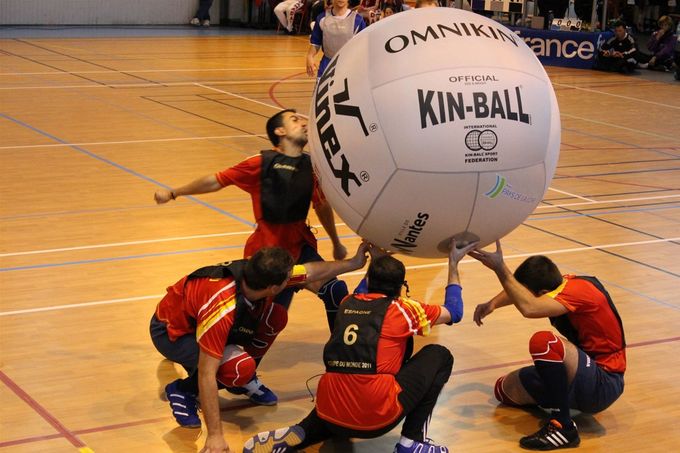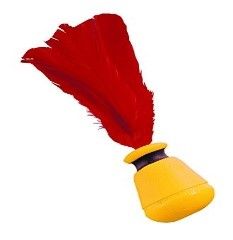Sitio web de Remigio Pérez Physical Education in Bilingual Proyects
ALTERNATIVE SPORTS/GAMES
Alternative games are new games with certain qualities:
-Their main objective is being entertaining and fun. NOT COMPETITIVE (NOT PROFESSIONAL) -They are not usual in Spain
-They have simple rules, and you can easily change them
-They require non conventional materials.
-There is not an official list of alternative sports, but some of them are:
-KIN-BALL, FRISBEE (ULTIMATE), JUGGLING, INDIACA, BASEBALL, PICHI BALL, HOCKEY,MATE, PADDLE MATE….. IN THIS UNIT, WE ARE GOING TO LEARN A BIT ABOUT THEM.
KIN-BALL
Kin-Ball, is a team sport created in Quebec, Canada in 1986 by Mario Demers, a physical education professor, in which the main distinctive characteristics are the big size of the ball (1.22 meters in diameter) and that the matches are played among three teams at the same time instead of traditional one-vs-one like the most of the team games.
The teams have to be mixed.(Boys and girls). Kin-Ball game The Kin-Ball itself has a diameter of 1.22 meters (48 inches) and weighs about 1 kilogram (2 pounds). The court is 20×20 meters (66×66 feet) in size. The line is part of the court. (The middle court of 5-a-side football or handball court.
There are 3 teams playing each game. Every team consists of 4 players. Each team also has an assigned color for the game. The official colors are black, grey and blue. Sometimes pink instead of blue is used. To make a play the attacking team, which is the one currently being in possession of the ball, has to designate a defending team by announcing a color. The designation has to start with the word "Omnikin" followed by the color of another team. After the designation the ball has to be hit with a body part above the hips, while all other members of the attacking team touch the ball in some way. If the defending team is able to control the ball successfully, it becomes the attacker.
A Kin-Ball Game is usually played until one team has won three periods. Each period takes about 10 minutes to play. When the first team reaches 11 points in a period, the team with the fewest points has to leave the court and the remaining two teams play until one team reaches 13 points.
A player can commit a series of fouls during the match: 1. Not being able to catch the ball before it touches the ground 2. Hitting the ball out of bounds or stepping out of bounds while touching the ball 3. Walking with the ball after the third player touches the ball during a play 4. Hitting the ball in a way, that it only has a downward trajectory 5. Hitting the ball less than 1.8 meters (60 inches) 6. Not all players of a team being in contact with the ball 7. Making a mistake during the color announcement (wrong color, more than one player talking, etc.) 8. Having more than 1 player within 1.8 meters during the hit (close defense) 9. Intentionally interfering with defending player Whenever a team commits a fault, the other two teams receive a point each. This also makes sure, that teams of a lower skill level are kept in the play, as long as they don't make to many mistakes of their own in a row.
INDIACA
Indiacas are originally from Brazil. In the ancient times, it consisted in a small sand sack with some feathers stuck in it. Nowadays it consists in a foam ball, heavier on its bottom, with some feathers in its upper part.
To play the indiaca, you can hit it with any part of your body or even with a racket. You can easily control it if you hit it with your hands, feet and joints (knee, elbow...)
How to play: there are various possibilities:
ALONE: You can try to keep it in the air hitting it with all your body, only with the feet, only with the joints... You can also try to do a circuit holding it in the air (follow a line, climb some stairs, pass under or over a fence...
IN PAIRS: You can try to hold it as long as possible in the air between the both of you. With only one hit each one of you, with two or more... Or you can play trying to score in a small court painted with a chalk...
INDIACA GAME: You can play in teams of two, three or more players, even six as in volleyball. You only need a net (or an elastic band to use as a net) and some chalk to draw a court on the floor.
FRISBEE
A frisbee (also called a flying disc or simply a disc) is a gliding toy or sporting item that is generally plastic and roughly 20 to 25 centimetres (8 to 10 in) in diameter with a lip,[1] used recreationally and competitively for throwing and catching, for example, in flying disc games. The shape of the disc, an airfoil in cross-section, allows it to fly by generating lift as it moves through the air while spinning. Flying discs are thrown and caught for free-form (freestyle) recreation and as part of many flying disc games.
The common use of the name as a generic term has put the trademark in jeopardy; accordingly, many "Frisbee" games are now known as "disc" games, like ultimate. Someone throwing a flying disc Person catching a flying disc Humans have been tossing disc-shaped objects since time immemorial. Fred Morrison discovered a market for the modern-day flying disc[6] in 1938 when he and future wife, Lucile, were offered 25 cents for a cake pan that they were tossing back and forth on a beach near Los Angeles, CA. "That got the wheels turning, because you could buy a cake pan for five cents, and if people on the beach were willing to pay a quarter for it, well—there was a business," Morrison told The Virginian-Pilot newspaper in 2007.[7] The Morrisons continued their business until World War ll, when Morrison served in the Army Air Force, flying P-47s, and then was a prisoner of war. Mustered out, Morrison sketched a design for an aerodynamically improved flying disc that he called the Whirlo-Way. By 1948, after design modifications and experimentation with several prototypes, Morrison and business partner Warren Franscioni began producing the first plastic discs, renaming them the Flyin-Saucer in the wake of reported unidentified flying object-sightings.
Disc sports:
Flying disc games and Flying disc freestyle
Guts The game of guts was invented by the Healy Brothers in the 1950s and developed at the International Frisbee Tournament (IFT) in Eagle Harbor, Michigan. Two teams of one to five team members stand in parallel lines facing each other across a court and throw flying discs at members of the opposing team.
Double disc court Double disc court was invented and introduced in the early 1970s by Jim Palmeri, a sport played with two flying discs and two teams of two players. Each team defends its court and tries to land a flying disc in the opposing court.
Disc golf This is a precision and accuracy sport in which individual players throw a flying disc at a target pole hole. In 1926, In Bladworth, Saskatchewan, Canada, Ronald Gibson and a group of his Bladworth Elementary school chums played a game using metal lids, they called “Tin Lid Golf.” In 1976, the game of disc golf was standardized with targets called "pole holes" invented and developed by Wham-O's Ed Headrick.
Freestyle competition In 1974, freestyle competition was created and introduced by Ken Westerfield and Discrafts Jim Kenner. Teams of two or three players are judged as they perform a routine that consists of a series of creative throwing and catching techniques set to music.
Ultimate The most widely played disc game began in the late 1960s with Joel Silver and Jared Kass. In the 1970s it developed as an organized sport with the creation of the Ultimate Players Association by Dan Roddick, Tom Kennedy and Irv Kalb. The object of the game is to advance the disc and score points by eventually passing the disc to a team member in the opposing team’s end zone. Players may not run while holding the disc.
Goaltimate A half-court disc game derived from Ultimate, similar to hot box. The object is to advance the disc on the field of play by passing, and score points by throwing the flying disc to a teammate in a small scoring area.
Disc dog Dogs and their human flying disc throwers compete in events such as distance catching and somewhat choreographed freestyle catching. Man plays KanJam. KanJam A patented game scoring points by throwing and deflecting the flying disc and hitting or entering the goal. The game ends when a team scores exactly 21 points or "chogs" the disc for an instant win.
ULTIMATE (FRISBEE)
Comentarios
Remigio Pérez
13.11.2020 07:49
Muchas gracias. Intentaré añadir este año más actividades enfocadas a este situación que nos toca vivir en relación a nuestra materia.
Comentarios recientes
05.10 | 09:57
Buenas tardes, encantado de saludarte. Soy Jose
Quería escribirte porque me ha parecido interesante comentar contigo la posibilidad de que tu negocio aparezca cada mes en periódicos digitales como not
08.09 | 09:54
Hola. ¿Cómo estás? Soy Alberto del Departamento de Prensa. Muchas gracias por atenderme.
He pensado que podría interesarte cómo podemos hacer que tu empresa aparezca en más de 50 periódicos digitales
23.07 | 05:21
Hola. ¿Cómo estás? Soy Alberto del Departamento de Prensa. Muchas gracias por atenderme.
He pensado que podría interesarte cómo podemos hacer que tu empresa aparezca en más de 50 periódicos digitales
24.04 | 16:48
Buenas tardes Alberto, te puedes poner en contacto conmigo mediante el correo electrónico, no veo ningún problema en que aparezca en prensa digital. Un saludo
Compartir esta página


